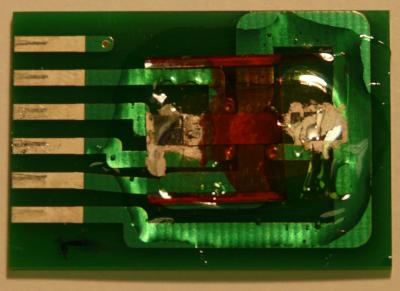
Physicists at University of Utah developed an inexpensive, highly accurate magnetic field sensor. This new magnetic field sensor, good for scientific or consumer uses is based on “spinotronic” organic thin film semiconductor which basically is a plastic paint resistant at heat and degradation.
This plastic paint is only about 5 by 5 mm (one fifth inch on a side) and the part used to detect magnetic fields is only 1 by 1 mm. The organic semiconductor paint is deposited on a thin glass substrate which is mounted onto a circuit board with an area of 20 by 30 mm.
The new magnetic field sensor is the first major result to come out at University of Utah and the physics professor Brian Saam, one of the center’s main investigators which says that this magnetic field sensor “is viewed widely as having exceptional impact in a host of real-world science and technology applications.”
This device could be on the market in three years or less if they can combine it with other technologies to make it faster.
Let’s see how it works. The sensors are based on a field of science named spintronics, in which data is stored both electronically in the electrical charges of electrons or atomic nuclei and in what is known as the “spin” of those subatomic particles.
Described simply, spin makes a particle behave like a tiny bar magnet that is pointed up or down within an electron or a nucleus. Down can represent 0 and up and represent 1, similar to how in electronics no charge represents 0 and a charge represents 1. Spintronics allows more information – spin and charge – to be used than electronics, which just uses charge.
The new magnetic field sensor paint contains negatively charged electrons and positively charged “holes” that align their spins parallel or not parallel in the absence or presence of a magnetic field – but only if radio waves of a certain frequency also are applied to the semiconductor paint.
So an electrical current is applied to the new device. Electrical contacts in the device act as tiny broadcast antennas to bombard the plastic paint with radio waves, which the researchers gradually change in frequency. If a magnetic field is present, the spins in the polymer paint will flip when the frequency of the radio waves matches the magnetic field. The change of spin in the paint is converted to an electrical current the researchers then read to determine magnetic field strength.
Because the paint is an organic polymer, the sensor is known as an organic spintronics device. The new device called magnetometer can detect magnetic fields ranging from 1,000 times weaker than Earth’s magnetic field to tens of thousands times stronger – a range that covers intermediate to strong magnetic fields, the scientist says. The main issue is to make it works faster than actual devices and this is their challenge.



